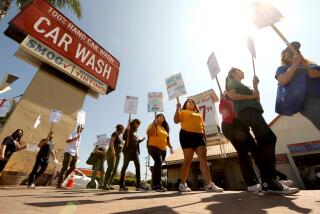No ‘Good Times’ for Cities
- Share via
Their pockets bulging with a $13-billion budget surplus, Gov. Gray Davis and the California Legislature have doled out billions for schools, transportation projects and tax cuts. But once again, the state’s 58 counties and 475 cities got stiffed. The $98.4-billion budget signed into law June 30 allocates a puny $200 million in one-time discretionary money to the state’s beleaguered local governments. This is a particular affront to the counties, which have no independent sources of revenue to fall back on when the going gets tough. Even in the best of times--now, for instance--the counties have to scrape to get by.
Los Angeles County, which needed a federal health care bailout to stave off bankruptcy in 1995, was forced to negotiate a new five-year, $1.2-billion federal deal last month to avert a crisis. Other counties around the state are doing better, but they too continue to be caught in the squeeze. For instance, they must administer programs dictated by Sacramento but do not always get enough state money to pay for them.
These are only the most obvious problems caused by the dysfunctional financial relationship between the state and the local governments. The twisted responsibilities are also partly responsible for urban sprawl, traffic congestion and a crisis in affordable housing. A special legislative committee is struggling to develop a fiscal reform program, but all previous efforts have failed. We urge state Sen. Steve Peace (D-El Cajon) and Assemblywoman Dion Aroner (D-Berkeley), co-chairs of a conference committee on state-local finance, to find a workable solution this summer.
Prior to 1978, cities and counties used local property taxes to finance traditional services such as fire and police protection, parks and libraries. But most of this tax base was lost in 1978 when voter-approved Proposition 13 clamped a 1% cap on the property tax rate. The Legislature then took over the collection and allocation of remaining property taxes.
The second blow came during the recession of the early 1990s. Facing a massive deficit, Sacramento commandeered $3 billion more in local property taxes to meet its obligation to public schools. This shift remains in effect though it has been partly offset by some new state aid. But when the state gives money back, it invariably earmarks it for specific programs. Local officials have virtually no discretion in how the money is used.
Meanwhile, the sales tax has grown in importance to local governments, prompting them to encourage big retail developments rather than housing. This has contributed to more sprawl, congestion and higher home prices.
The fiscal tangle is incredibly complex. Layers on layers of successive laws and regulations give Sacramento ever more control over how local money is spent. This is a power that state lawmakers and governors seem incapable of surrendering, but the cycle must be broken. The only hope for action this year rests with the Peace-Aroner committee, which also could use a measure of encouragement, or persuasion, from Gov. Davis.
More to Read
Get the L.A. Times Politics newsletter
Deeply reported insights into legislation, politics and policy from Sacramento, Washington and beyond. In your inbox three times per week.
You may occasionally receive promotional content from the Los Angeles Times.










